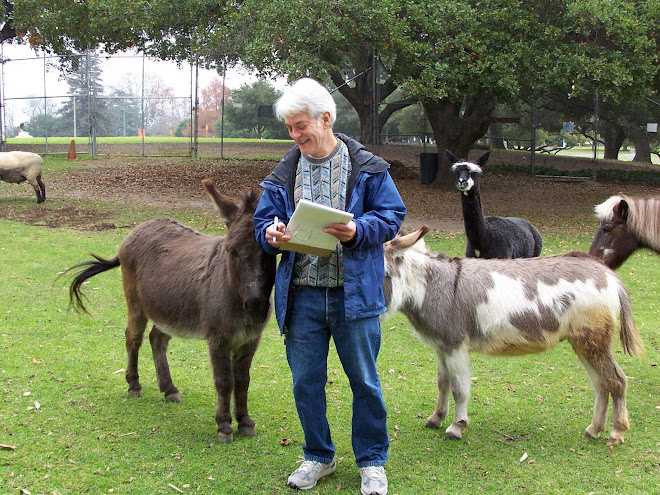
(Above: The Blue Fairy telling stories and singing songs at Fairyland.)
In 1948 Arthur Navlet, owner of one of Oakland's largest floral nurseries, had an idea for a children's park on the shores of Lake Merritt that would be unlike any other - not a frenetic mini-carnival, but a safe, quiet, comforting environment where children could play at their own pace and on their own terms.
He took his idea to Oakland Parks Superintendent William Penn Mott, who immediately signed on, and the Lake Merritt Breakfast Club, which pledged its support.
To design the new park, which would be called Children's Fairyland, Mott chose architect William Russell Everett.
Everett built a tiny model of the first attraction, the Merry Miller Cottage. It was a perfect replica of a medieval English cottage, and he was delighted with the result.
But Mott was not. He didn't want realism; he wanted whimsy, a little nonsensical and out of kilter - the way a small child might view the grownup world.
Enraged by the criticism, Everett grabbed a baseball bat, smashed the model to smithereens, and stalked out of the room.
Mott and Navlet were sure that was the last they'd ever hear from him. But a week later, he returned with a new model. It was oddly twisted and had no square sides, and it was painted in outlandish colors.
"That's it!" Mott exclaimed.
Thus was born the principle that has ruled Children's Fairyland ever since - "no straight lines and a surprise around every corner."
Everett went on to achieve fame and fortune as the nation's foremost designer of miniature golf courses, using the ideas he first developed at Fairyland.
And Fairyland became the model for Walt Disney when he built Disneyland. He even hired away Fairyland's first director, Dorothy Manes, and its first puppeteer, Bob Mills, for his new park.
But I much prefer the original. For six decades, Children's Fairyland has been what Mott and Navlet intended it to be: an oasis of serenity in the midst of the big city, where little kids can run free and just be little kids.
And it's all beautifully documented in a new book, "Creating a Fairyland: 60 Years of Magic at Children's Fairyland USA" by Randal Metz and Tony Jonick.
Each page is packed with memories, including:
* 10-year-old Beth Werschkul, the very first Storybook Personality, who was Alice in Wonderland in 1960.
* Popo the Clown and his six-legged cow, who enchanted generations of children from 1958 until his death in 1981.
* Master puppeteer Lewis Mahlmann, who directed the Storybook Puppet Theater from 1967 until 2003.
* The Blue Fairy (real name: Jacqueline Lynaugh), whose songs and stories have brought fairytales to life for the park's pint-sized visitors for more than 20 years.
* And, of course, all the adorable animals who have lived at Fairyland over the years, from Emo the Saint Bernard, who used to haul kids around the park in his dog cart - a tradition that was carried on by his son, Jamie, and his grandson, Hondo - to the charming but naughty miniature donkeys Gideon and Tumbleweed Tommy - aka "the bad boys" - who get into mischief every chance they get.
(In the old days Fairyland used to hold an annual Aesop's Derby, featuring races between turtles and rabbits. This being real life and not myth, the rabbits always won.)
Metz and Jonick are the perfect people to write this book. A former Storybook Personality himself, Metz is the current director of the puppet theater.
And Jonick, who met his wife at Fairyland, has been a fan ever since he was a little kid growing up in the Fiji Islands, when he read about Fairyland in a "Dennis the Menace" comic book.
Chock full of priceless pictures, "Creating a Fairyland" is the next best thing to visiting the park itself. It's available at Fairyland's Magic Leaf gift shop, A Great Good Place for Books in Montclair, Laurel Book Store on MacArthur Boulevard or Spectator Books on Piedmont Avenue.
At 60, Fairyland looks better than ever. But the important things will never change.
Children are still warned not to cross the Magic Pink Line in front of the puppet theater because if they get any closer, the puppets will become frightened and run off the stage. (Although the cynical grownup in me suspects that the real reason is that the kids will see the puppets' strings.)
And I hope you've hung on to your Magic Key because it still works.















